ESP RENAULT TWIZY 2018 User Guide
[x] Cancel search | Manufacturer: RENAULT, Model Year: 2018, Model line: TWIZY, Model: RENAULT TWIZY 2018Pages: 118, PDF Size: 2.51 MB
Page 36 of 118
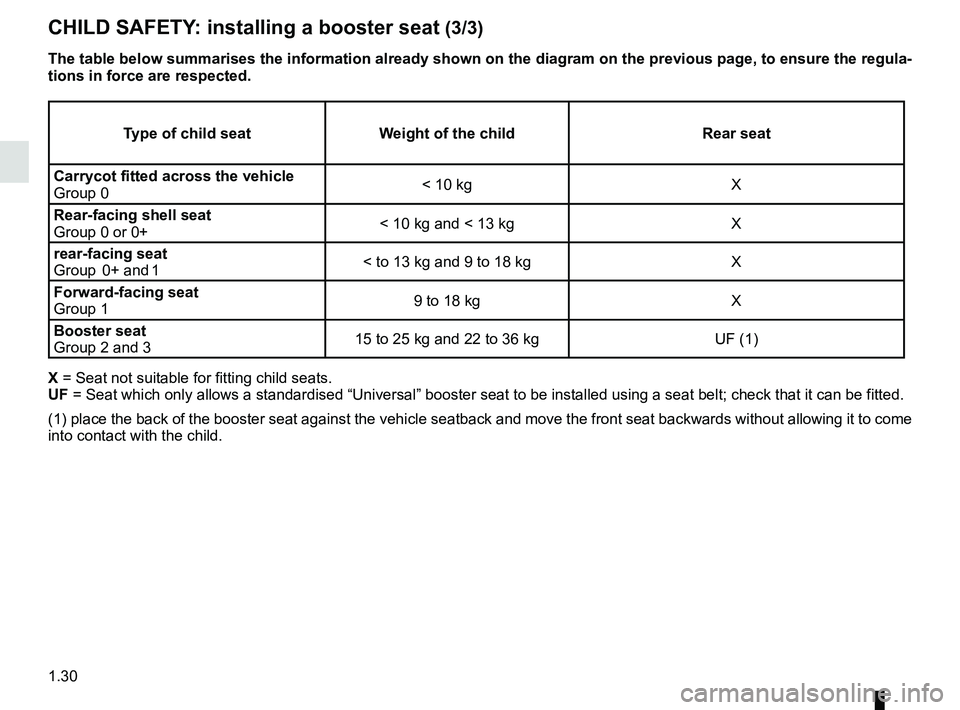
1.30
CHILD SAFETY: installing a booster seat (3/3)
Type of child seatWeight of the child Rear seat
Carrycot fitted across the vehicle
Group 0 < 10 kg
X
Rear-facing shell seat
Group 0 or 0+ < 10 kg and < 13 kg
X
rear-facing seat
Group 0+ and 1 < to 13 kg and 9 to 18 kg
X
Forward-facing seat
Group 1 9 to 18 kg
X
Booster seat
Group 2 and 3 15 to 25 kg and 22 to 36 kg
UF (1)
X = Seat not suitable for fitting child seats.
UF = Seat which only allows a standardised “Universal” booster seat to \
be installed using a seat belt; check that it can be fitted.
(1) place the back of the booster seat against the vehicle seatback an\
d move the front seat backwards without allowing it to co me
into contact with the child. The table below summarises the information already shown on the diagram \
on the previous page, to ensure the regula-
tions in force are respected.
Page 45 of 118

1.39
HORN
Electric vehicles are particularly quiet.
This system enables you to warn
people of your presence – especially
pedestrians and cyclists.
Activating the system
With the engine running, turn centre
ring 1 on the stalk until the symbol
ṫ
faces mark 2.
Deactivating the system
Turn the centre ring 1 to position 0
again.
12
Page 50 of 118

2.2
“Accessories” position ANo power-consuming device will oper-
ate when the ignition is switched off.
“On” position MThe ignition is switched on:
Start position D
Starting the engine
Turn the key to the D position and hold
it in this position until you hear a beep.
Release the key.
As soon as warning light
Ṑ stops
flashing, your vehicle is ready to drive.“Stop, steering and
handbrake lock” position St
To unlock: turn the key and the steering
wheel slightly.
To lock: remove the key and turn the
steering wheel until the steering column
locks.
To release the handbrake, please see
the information on “Handbrake” in
Section 2.
STARTING, STOPPING THE ENGINE
The vehicle cannot be started if the
charging cord is plugged in and
powered or if the charging flap is
open.
Stopping the engine
Bring the key to “Stop” position.
Warning light
Ṑ goes out.
Driver’s responsibility
when parking or stopping
the vehicle
Never leave an animal,
child or adult who is not self-suffi-
cient alone on your vehicle, even for
a short time.
They may pose a risk of injury, such
as by starting the engine or activat-
ing equipment.
Risk of serious injury.
Page 55 of 118
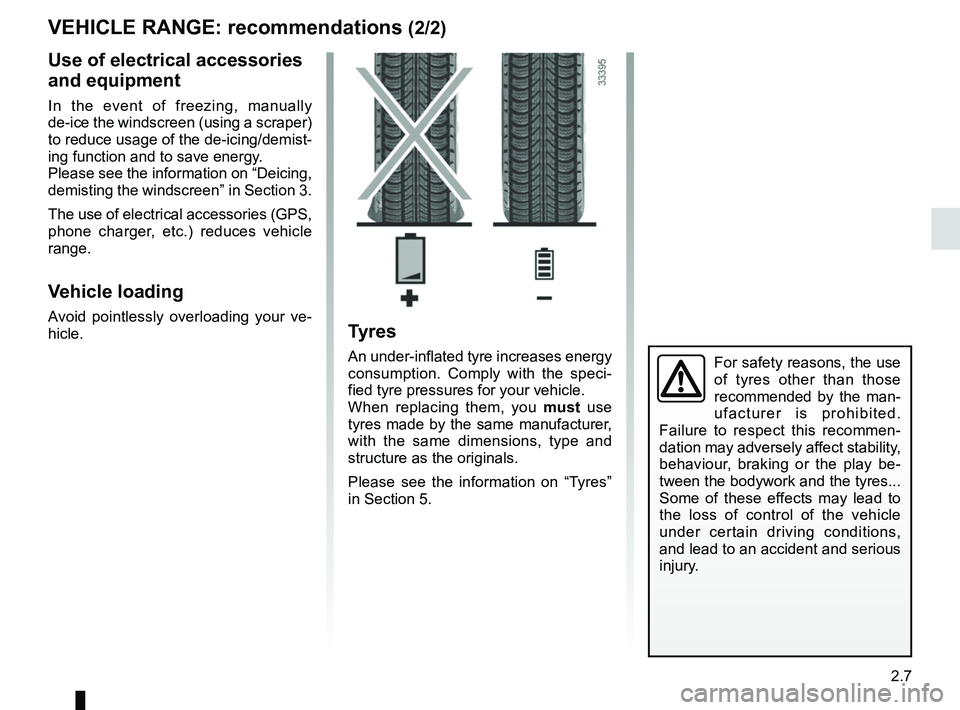
2.7
VEHICLE RANGE: recommendations (2/2)
Tyres
An under-inflated tyre increases energy
consumption. Comply with the speci-
fied tyre pressures for your vehicle.
When replacing them, you must use
tyres made by the same manufacturer,
with the same dimensions, type and
structure as the originals.
Please see the information on “Tyres”
in Section 5.
Use of electrical accessories
and equipment
In the event of freezing, manually
de-ice the windscreen (using a scraper)
to reduce usage of the de-icing/demist-
ing function and to save energy.
Please see the information on “Deicing,
demisting the windscreen” in Section 3.
The use of electrical accessories (GPS,
phone charger, etc.) reduces vehicle
range.
Vehicle loading
Avoid pointlessly overloading your ve-
hicle.
For safety reasons, the use
of tyres other than those
recommended by the man-
ufacturer is prohibited.
Failure to respect this recommen-
dation may adversely affect stability,
behaviour, braking or the play be-
tween the bodywork and the tyres...
Some of these effects may lead to
the loss of control of the vehicle
under certain driving conditions,
and lead to an accident and serious
injury.
Page 56 of 118
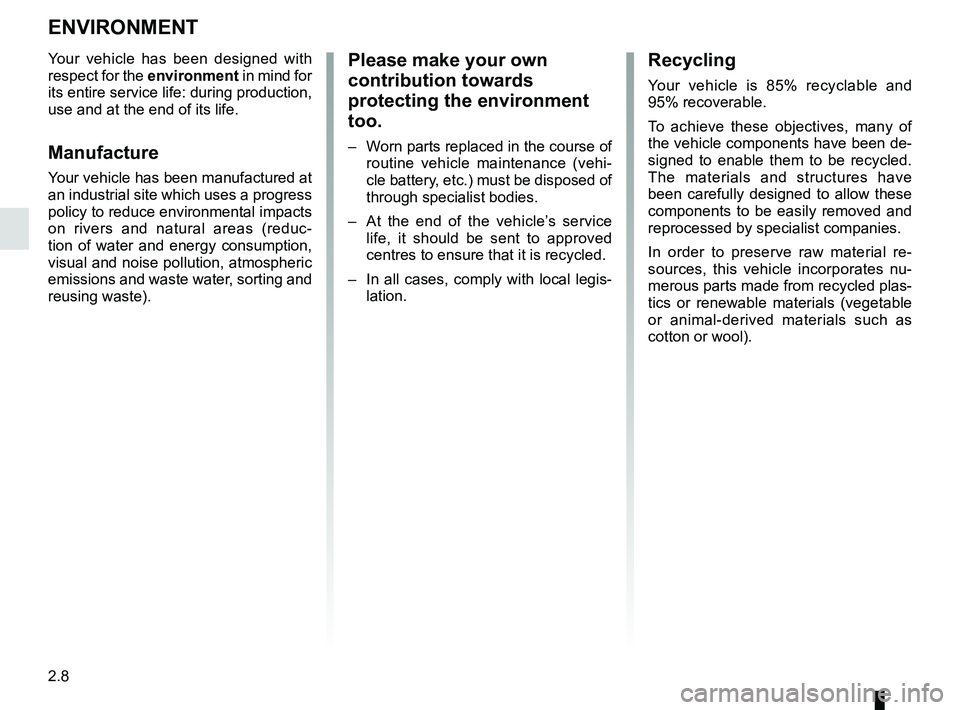
2.8
ENVIRONMENT
Please make your own
contribution towards
protecting the environment
too.
– Worn parts replaced in the course of routine vehicle maintenance (vehi-
cle battery, etc.) must be disposed of
through specialist bodies.
– At the end of the vehicle’s service life, it should be sent to approved
centres to ensure that it is recycled.
– In all cases, comply with local legis- lation.
Recycling
Your vehicle is 85% recyclable and
95% recoverable.
To achieve these objectives, many of
the vehicle components have been de-
signed to enable them to be recycled.
The materials and structures have
been carefully designed to allow these
components to be easily removed and
reprocessed by specialist companies.
In order to preserve raw material re-
sources, this vehicle incorporates nu-
merous parts made from recycled plas-
tics or renewable materials (vegetable
or animal-derived materials such as
cotton or wool).
Your vehicle has been designed with
respect for the environment in mind for
its entire service life: during production,
use and at the end of its life.
Manufacture
Your vehicle has been manufactured at
an industrial site which uses a progress
policy to reduce environmental impacts
on rivers and natural areas (reduc-
tion of water and energy consumption,
visual and noise pollution, atmospheric
emissions and waste water, sorting and
reusing waste).
Page 64 of 118
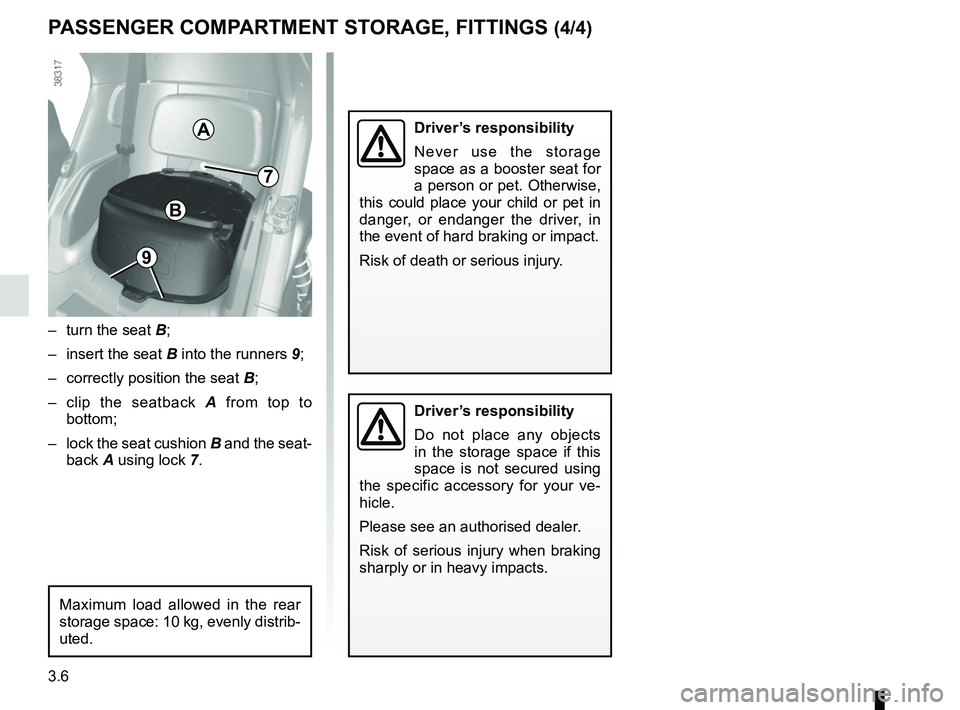
3.6
Driver’s responsibility
Never use the storage
space as a booster seat for
a person or pet. Otherwise,
this could place your child or pet in
danger, or endanger the driver, in
the event of hard braking or impact.
Risk of death or serious injury.
Driver’s responsibility
Do not place any objects
in the storage space if this
space is not secured using
the specific accessory for your ve-
hicle.
Please see an authorised dealer.
Risk of serious injury when braking
sharply or in heavy impacts.
PASSENGER COMPARTMENT STORAGE, FITTINGS (4/4)
B
– turn the seat B;
– insert the seat B into the runners 9;
– correctly position the seat B;
– clip the seatback A from top to
bottom;
– lock the seat cushion B and the seat-
back A using lock 7.
7
A
9
Maximum load allowed in the rear
storage space: 10 kg, evenly distrib-
uted.
Page 68 of 118

4.4
12V BATTERY (1/2)
The secondary battery is a 12 V battery:
this supplies the energy required to op-
erate vehicle equipment (lights, wind-
screen wipers, audio system, etc) and
certain safety systems, such as ABS.
For your safety and the
proper operation of the
vehicle’s electrical equip-
ment (lights, windscreen
wipers, etc.), any work on the se-
condary 12V battery (removal, dis-
connection, etc.) must be carried
out by a specialist.
Risk of serious burns or electric
shocks.
Respect categorically the replace-
ment intervals (without exceeding
them) as stated in the maintenance
document.
The battery is a specific type.
Please ensure it is replaced with the
same type.
Contact an Authorised Dealer.
A123
456
Label A
Observe the indications on the battery:
– 1 naked flames and smoking are for-
bidden;
– 2 eye protection required;
– 3 keep away from children;
– 4 explosive materials;
– 5 please consult the driver’s hand-
book;
– 6 corrosive materials.
Page 70 of 118
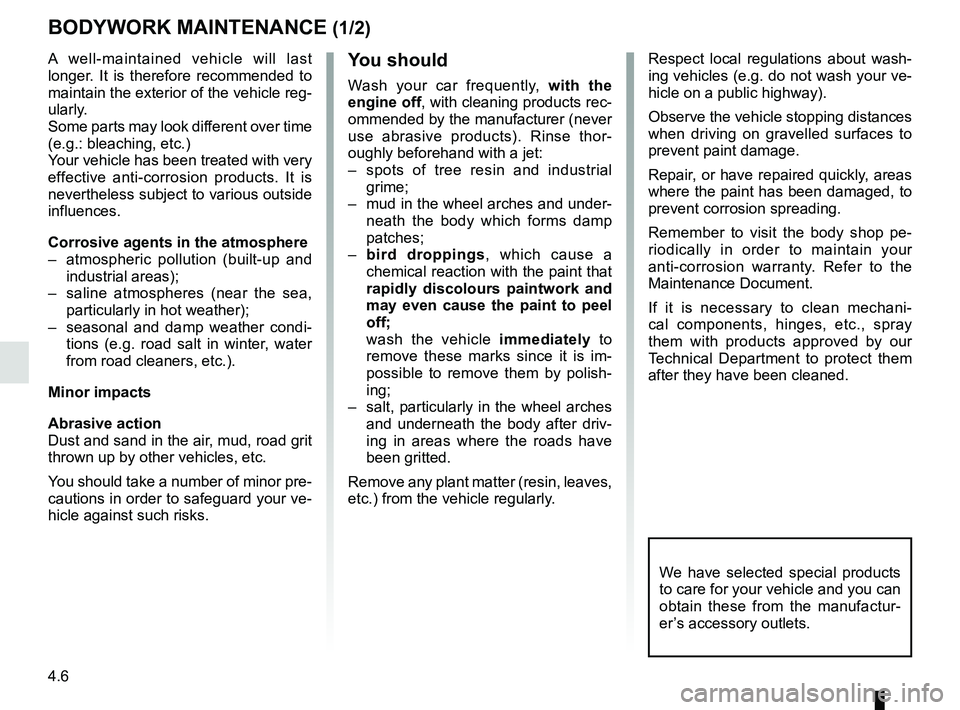
4.6
BODYWORK MAINTENANCE (1/2)
A well-maintained vehicle will last
longer. It is therefore recommended to
maintain the exterior of the vehicle reg-
ularly.
Some parts may look different over time
(e.g.: bleaching, etc.)
Your vehicle has been treated with very
effective anti-corrosion products. It is
nevertheless subject to various outside
influences.
Corrosive agents in the atmosphere
– atmospheric pollution (built-up and
industrial areas);
– saline atmospheres (near the sea,
particularly in hot weather);
– seasonal and damp weather condi-
tions (e.g. road salt in winter, water
from road cleaners, etc.).
Minor impacts
Abrasive action
Dust and sand in the air, mud, road grit
thrown up by other vehicles, etc.
You should take a number of minor pre-
cautions in order to safeguard your ve-
hicle against such risks.You should
Wash your car frequently, with the
engine off , with cleaning products rec-
ommended by the manufacturer (never
use abrasive products). Rinse thor-
oughly beforehand with a jet:
– spots of tree resin and industrial
grime;
– mud in the wheel arches and under-
neath the body which forms damp
patches;
– bird droppings , which cause a
chemical reaction with the paint that
rapidly discolours paintwork and
may even cause the paint to peel
off;
wash the vehicle immediately to
remove these marks since it is im-
possible to remove them by polish-
ing;
– salt, particularly in the wheel arches
and underneath the body after driv-
ing in areas where the roads have
been gritted.
Remove any plant matter (resin, leaves,
etc.) from the vehicle regularly. Respect local regulations about wash-
ing vehicles (e.g. do not wash your ve-
hicle on a public highway).
Observe the vehicle stopping distances
when driving on gravelled surfaces to
prevent paint damage.
Repair, or have repaired quickly, areas
where the paint has been damaged, to
prevent corrosion spreading.
Remember to visit the body shop pe-
riodically in order to maintain your
anti-corrosion warranty. Refer to the
Maintenance Document.
If it is necessary to clean mechani-
cal components, hinges, etc., spray
them with products approved by our
Technical Department to protect them
after they have been cleaned.
We have selected special products
to care for your vehicle and you can
obtain these from the manufactur-
er’s accessory outlets.
Page 77 of 118

5.3
TYRES (2/4)
Tyre pressures
Respect the tyre pressures, checking
them at least once a month and before
any long journeys.
Pressures should be checked when the
tyres are cold; ignore higher pressures
which may be reached in hot weather
or following a fast journey. If tyre pressures cannot be checked
when the tyres are
cold, the normal
pressures must be increased by 0.2 to
0.3 bar (or 3 PSI).
Never deflate a hot tyre.
Use in winter
The use of snow or winter tyres signifi-
cantly reduces the vehicle range.
Incorrect tyre pressures
lead to abnormal tyre wear
and unusually hot running.
These are factors which
may seriously affect safety and lead
to:
– poor road holding,
– risk of bursting or tread separa- tion.
The pressure depends on the load
and the speed of use. Adjust the
pressure based on the user condi-
tions.
Please be aware that a
poorly tightened or miss-
ing valve cap can make the
tyres less airtight and lead
to pressure loss.
Always use valve caps identical to
those fitted originally and tighten
them fully.
Snow or Winter tyres
We would recommend that these be
fitted to all four wheels to ensure that
your vehicle retains maximum adhe-
sion.
Warning : These tyres sometimes have
a specific direction of rotation and a
maximum speed index which may be
lower than the maximum speed of your
vehicle.
You must use tyres made by the same
manufacturer, with the same dimen-
sions, type and structure.
Chains
In all cases, we would recommend
that you contact an approved dealer
who will be able to advise you on
the choice of equipment which is
most suitable for your vehicle.
For safety reasons, the use
of chains is strictly forbid-
den.
Page 78 of 118
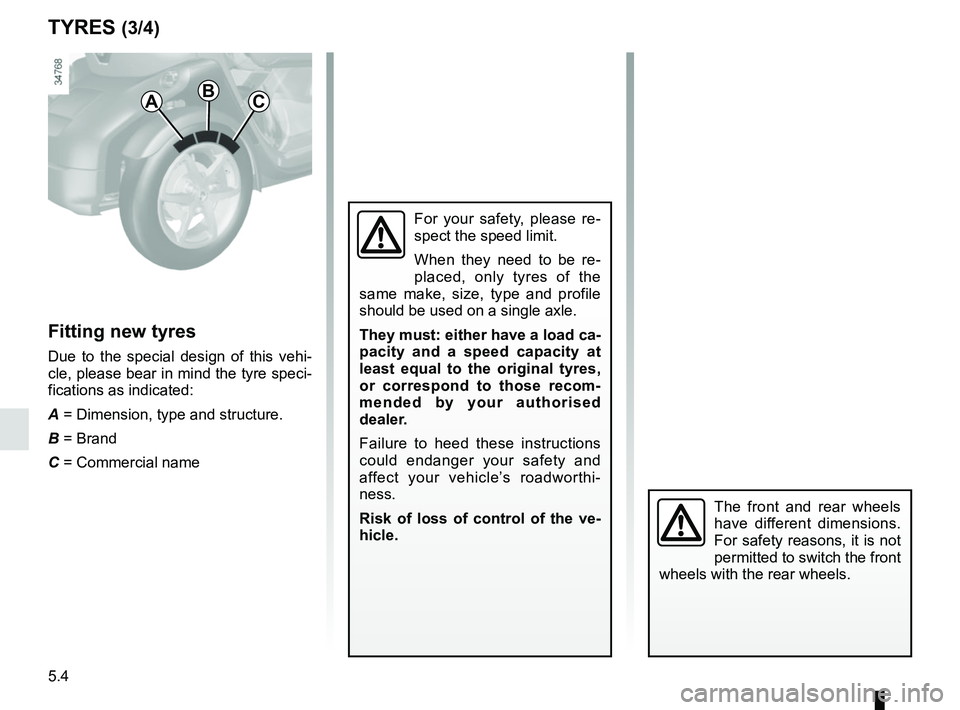
5.4
TYRES (3/4)
Fitting new tyres
Due to the special design of this vehi-
cle, please bear in mind the tyre speci-
fications as indicated:
A = Dimension, type and structure.
B = Brand
C = Commercial name
ABC
The front and rear wheels
have different dimensions.
For safety reasons, it is not
permitted to switch the front
wheels with the rear wheels.
For your safety, please re-
spect the speed limit.
When they need to be re-
placed, only tyres of the
same make, size, type and profile
should be used on a single axle.
They must: either have a load ca-
pacity and a speed capacity at
least equal to the original tyres,
or correspond to those recom-
mended by your authorised
dealer.
Failure to heed these instructions
could endanger your safety and
affect your vehicle’s roadworthi-
ness.
Risk of loss of control of the ve-
hicle.